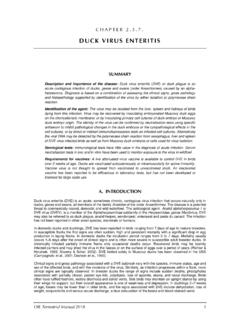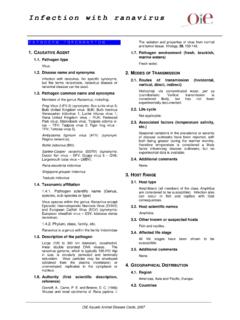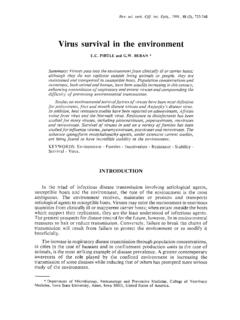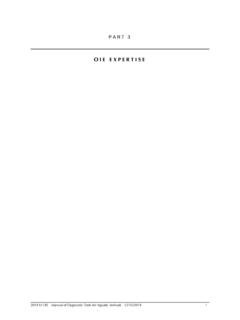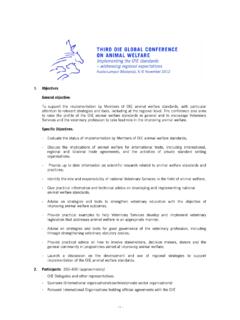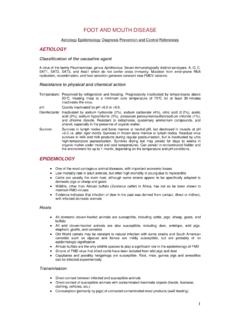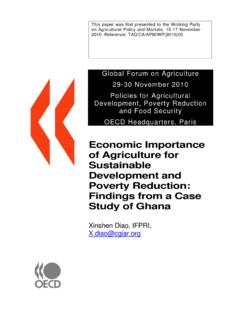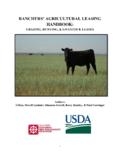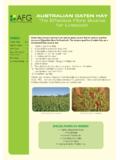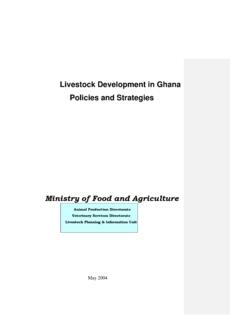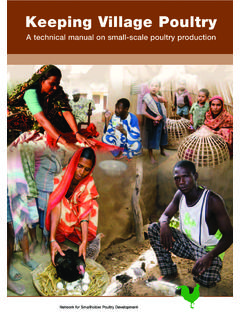Transcription of THE IMPORTANCE OF LIVESTOCK IDENTIFICATION AND …
1 THE IMPORTANCE OF LIVESTOCK IDENTIFICATION AND movement . control TO THE PROMOTION OF ANIMAL DISEASE control . AND FACILITATION OF TRADE. John Edwards Regional Coordinator, OIE SEAFMD Regional Coordination Unit, Phaya Thai Road, Bangkok 10400, Thailand Original: English Summary: LIVESTOCK IDENTIFICATION and the management of LIVESTOCK movements are critical to the control of animal diseases and access to trade in animals and animal products. International standards for the control of animal diseases and for trade in LIVESTOCK and LIVESTOCK products are established under the WTO SPS Agreement. The OIE has the mandate from the WTO to set standards, guidelines and recommendations in relation to trade of LIVESTOCK and LIVESTOCK products. Many of the standards are incorporated in the OIE International Animal Health Code. These standards pose significant challenges for many developing countries where OIE List A and List B diseases are endemic and the animal health services have limited resources and capacity to deliver effective animal health programmes.
2 Members of the OIE Regional Commission for Africa were surveyed on aspects of LIVESTOCK movement control and animal IDENTIFICATION . Respondents described variable the capacity to implement systems for traceability and management of animal movements. The main obstacles to increasing trade were poor animal health status and the limited capacity of many animal health services. Most countries have multiple neighbours and only half the countries are actively engaging their neighbours in collaboration on LIVESTOCK movement control . Members indicated that illegal movements are common in most countries. More than half the countries implement charges for LIVESTOCK movements and incentives to encourage legal movements were used by relatively few countries. The most influential private stakeholders were thought to be LIVESTOCK owners, LIVESTOCK producer organisations, traders and exporters.
3 The majority of members supported improved communication and active participation as the means of increasing private sector support for national programmes for LIVESTOCK IDENTIFICATION and movement management. LIVESTOCK IDENTIFICATION systems and registration of identifiers are in place in most countries, however, low cost traditional IDENTIFICATION methods are most commonly used and data is recorded manually in most cases. Cost and cultural reasons are the main obstacles to adoption of more sophisticated methods. Recommendations arising from this paper related to the need for Member Countries to adopt harmonised approaches to LIVESTOCK IDENTIFICATION and movement management and that improved disease control and increased access to trade will require strong co-operation between neighbouring countries and active participation by stakeholder groups.
4 1. INTRODUCTION. LIVESTOCK movements are the major avenue for the spread of animal diseases and hence are the most important obstacle to the control of animal diseases in most parts of the world. LIVESTOCK IDENTIFICATION is an important tool that is an essential component of programmes for controlling animal diseases and to ensure the traceability and safety of LIVESTOCK and LIVESTOCK products. Traceability of LIVESTOCK and LIVESTOCK products is becoming increasingly important in the areas of public health and consumer protection (1). At the 14th Conference of the OIE Regional Commission for Africa the IMPORTANCE of LIVESTOCK movement control and LIVESTOCK IDENTIFICATION in relation to disease control and access to trade were identified as important topics for consideration at the next meeting. In December 2002, a questionnaire containing 25 questions on aspects of LIVESTOCK movement control and animal IDENTIFICATION was distributed to Member Countries.
5 Responses were received from Algeria, Botswana, Egypt, Ghana, Guinea, Mali, Morocco, Mauritius, Tanzania, Uganda, Zambia and Zimbabwe. There are no specific definitions in the International Animal Health Code (1) for LIVESTOCK movement control and LIVESTOCK IDENTIFICATION and, therefore, the following descriptions were used to help Member Countries to complete the questionnaire. LIVESTOCK movement control involves the carrying out of any procedure to manage or control the movement of LIVESTOCK species and it includes: Activities at check points, quarantine stations and by field staff to implement internal or international quarantine procedures, Carrying out responsibilities by LIVESTOCK owners and all persons involved in trade in LIVESTOCK , Legislative support, Incentives and penalties to encourage compliance, Maintaining records or databases of animal movements, Consultation with national and international stakeholders, Implementing relevant public awareness activities.
6 IDENTIFICATION of LIVESTOCK involves all aspects of IDENTIFICATION and traceability of LIVESTOCK and their products and includes: Methods of IDENTIFICATION of LIVESTOCK to the herd or individual animal level and this includes colour markings, branding, marks in the ears or other parts of the body, tags applied to any part of the body, biological markers and electronic forms of IDENTIFICATION , Documentation required for movements of LIVESTOCK including permits, waybills, animal passports, etc. Legislation required to approve, enforce and prevent the removal or defacing of identifiers, Maintaining registers or records of animals and herds, and these can be manual or electronic, Implementing public awareness activities. This paper describes the IMPORTANCE of LIVESTOCK movement control and LIVESTOCK IDENTIFICATION to the promotion of animal disease control and facilitation of trade in animals and animal products.
7 2. INTERNATIONAL DEVELOPMENTS IN LIVESTOCK movement control . The movement of LIVESTOCK and their products has increased due to globalisation of trade. This has increased the spread of disease, increased the threats to human health and reduced consumer confidence in animal products (1). Significant changes are occurring in the international environment for trade in animals and animal products as a result of the establishment of the World Trade Organization (WTO) and the impacts of globalisation. These changes are aimed to create a more transparent, scientific and risk based approach throughout the production chain. There are some signs that non justified barriers to trade in animals are being reduced. However, for many countries there are significant challenges to overcome before the benefits can be achieved. This includes the ability to control serious diseases of LIVESTOCK and to meet the needs of importing countries in accordance with the WTO's Sanitary and Phyto-sanitary (SPS) (4) Agreement.
8 The SPS Agreement offers potential for increased trade. However, it also preserves the right of importing countries to protect their animal health status by transparent and scientifically justifiable means. It also includes the concept of Appropriate Level of Protection (ALOP) whereby a country can choose a level of protection that it considers necessary to protect human or animal health. The OIE is given the responsibility for setting standards under this agreement and these are included in its International Animal Health Code (2). The Code also defines zoning1 and regionalisation2 as means of making progress with disease control and demonstrating different levels of animal health status. The standards required for movements of animals and animal products between zones/regions are also described. It is important to understand the legal and illegal movement patterns of animals within a region.
9 These are often significant avenues of disease risk and animal movement pathways will change periodically. This will depend on price. Monitoring LIVESTOCK prices can be used to monitor potential changes in LIVESTOCK movement patterns. It is important to recognise that these types of movements do occur and often in large numbers. The challenge is to manage these movements to minimise the risks. This requires an integrated approach to animal movement management involving planning, education, incentives, legislation and penalties when required. Some traditional approaches to LIVESTOCK movement control result in an increased spread of disease, because they drive movements around the legal checkpoints or do not serve any useful disease control function. In many cases, LIVESTOCK movements within and between countries/zones are traditional and have been going on for a long time, and are considered as normal activities of people in the region.
10 It may be necessary to recognise that these movements occur and that instead of tightening restrictions or banning such movements, it is often more effective to recognise them as legitimate trade in the region and to minimise the disease risks by managing these movements. For this purpose, bilateral and regional cooperation is essential. In many parts of the world, there is a culture of mindless application of quarantine procedures and the establishment of checkpoints to control animal movements. Quarantine and check points should only be necessary for movements between countries/zones of different animal health status. Zones of different animal health status often do not follow national borders. It is more important to manage movements between zones of different status than across national borders. Therefore, it is important to review the role, function and effectiveness of existing and planned animal quarantine stations/check posts.
